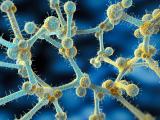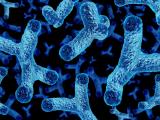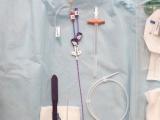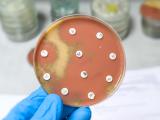James Hedrick, PhD, knows what it's like to have a serious bacterial infection. He also knows how much worse it could have been.
The Staphylococcus infection occurred 2 years ago, after Hedrick, a scientist at IBM Research-Almaden in California, underwent surgery to repair the patellar tendon in his knee. The infection, which was not resistant to antibiotics, kept him in the hospital for 9 days.
"The infection was the most painful thing I've ever gone through," Hedrick said in an interview. "Now fortunately, it was only Staph, and it was treatable. Had it been one of those gram-negatives, I would have been in a lot of trouble."
Hedrick said the incident has inspired him to focus on finding a new solution for those troubling gram-negatives—multidrug-resistant pathogens like Klebsiella pneumoniae, Escherichia coli, Acinetobacter baumannii, and Pseudomonas aeruginosa, which are among the most dangerous antibiotic-resistant threats facing healthcare systems around the world. A potential solution comes in the form of synthetic polymers that have shown the ability to kill these superbugs in lab cultures and animal infection models, with a unique way of eliminating bacteria with limited side effects.
Hedrick and an international team of researchers described their work recently in Nature Communications.
Killing bacteria in a less disruptive way
The synthetic polymers developed by Hedrick and colleagues from Singapore's Institute of Bioengineering and Nanotechnology are an inexpensive class of biocompatible and biodegradable materials that function similarly to antimicrobial peptides, which are intrinsic parts of the human immune system that kill bacteria in a variety of ways—mainly through their interaction with the bacterial membrane—but have limited applications in the clinic.
Hedrick said the team's early work with these polycarbonates, as they're called, showed that they demonstrated the ability to kill gram-positive bacteria like methicillin-resistant Staphylococcus aureus (MRSA) through massive disruption of the bacterial membrane. But gram-negative bacteria presented a more difficult challenge, because killing gram-negative bacteria through membrane disruption can release toxins into the bloodstream and induce septic shock.
"That was the first problem we saw," Hedrick said. "For many of the clinicians we talked to, it made them nervous."
As is the challenge faced by all scientists working on antibiotic development, they needed to find a way to kill gram-negatives without the potentially toxic side effects.
One of the advantages of working with polycarbonates, Hedrick explained, is that they are essentially a platform for drug development; different components can be added to the basic polymer structure very precisely to create molecules with a specific function and target. Hedrick and his colleagues soon found that appending guanidinium groups to the polycarbonates created a molecule that can target both gram-positives and gram-negatives in a more effective—and much less disruptive—way.
The guanidinium-functionalized polycarbonates have a unique method of action. Instead of destroying the bacterial membrane, they latch onto the bacterial cell, and then are transported across the cell membrane and into the cytosol—the gel-like substance enclosed within the cell membrane. "They're kind of hitchhiking their way in," Hedrick said.
Once inside, the polycarbonates kill the bacterial cell from within, leaving the membrane intact. "This is really the key behind this story," Hedrick said. "We have a very distinctive mechanism, we don't induce anything like septic shock, and through this mechanism we kill 100% of the bacteria very cleanly."
And because the polycarbonates are biodegradable, they don't stick around in the body. "These materials were basically designed to do their job and go away," Hedrick said. "There's no chance of any buildup in the body."
When tested in vitro against clinically isolated strains of four multidrug-resistant microbes—E coli, A baumannii, K pneumoniae, and MRSA—the polycarbonates exerted significant bactericidal activity, eradicating the bacteria quickly and much more effectively than imipenem and vancomycin, the control drugs they were tested against. Increasing the concentration of the polycarbonates produced even quicker results.
Tested in mouse infection models, including peritonitis (an infection of the stomach's inner lining) caused by multidrug-resistant E coli, K pneumoniae, A baumannii, MRSA, and Pseudomonas aeruginosa, the polycarbonates again proved highly effective, killing the bacteria quickly, with no toxic side effects.
But perhaps what excites Hedrick the most are the results of an additional experiment. To see whether bacteria will become resistant to the treatment, the researchers treated A baumannii cells 30 times with sub-lethal doses of the polycarbonates. After 30 passages, they found no development of resistance.
"We saw absolutely no loss of efficacy," Hedrick said. In contrast, the A baumannii cells started to develop resistance to imipenem after eight passages.
Potential for other types of therapy
Hedrick said the team will continue to refine the polycarbonates and conduct more genomic testing to better understand why they don't garner resistance. They're also exploring how polymer chemistry can be used to develop other therapies, including anti-cancer drugs. "The antimicrobial work has led us into a whole class of materials for what we call macromolecular chemotherapeutics," he said.
Hedrick said his team is getting help with additional testing from the National Institutes of Health. But because IBM isn't in the drug development business, developing polycarbonates into a clinically useful antibiotic therapy will most likely require partnering with a pharmaceutical company or biotechnology start-up.
"It took an army to do this work…doctors, bioengineers, chemists, genomic people…it's incredibly complex," he said. "Now we're looking to move it to the next step."
See also:
Mar 2 Nat Commun study






















